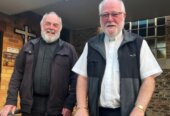‘…documentaries and tv shows can also be surprisingly inaccurate.’
Over the years I have responded to eruptions by giving information through social media and over 200 media interviews around the world.
This has meant that I have seen a lot of what is posted and shared online, what goes viral, and what is splashed across headlines. It is scary just how much “information” shared online is somewhere between inaccurate to total junk.
Working with many reporters I have only had a couple of instances where I feel that what I said was skewed or misrepresented. Every other reporter or journalist has worked hard to grasp a complex topic in a short amount of time, under pressure, to get out accurate information to the world. I spent 10 years in universities getting three degrees, with additional experience, to become a volcanologist. There is no reasonable way that I can expect anyone outside of my field to accurately report on volcanoes 100 per cent of the time, no matter how valiantly they try.
Then there are tabloids (especially from the US and UK in my experience) and social media users, who seem to have much less strict fact-checking ethics. I have seen the most rubbish and harmful claims go viral, while experts have a much smaller reach and are left trying to keep up.
Sadly, documentaries and tv shows can also be surprisingly inaccurate. All of this results in masses of misinformation living permanently across the internet. When you are trying to find the truth, the odds are not in your favour. Volcanoes are a generally benign topic, there aren’t a whole lot of conspiracy theories, and they usually aren’t a political rage point, yet misinformation is rampant and so casually thrown around as fact. This intensifies when a volcano or eruption hits the news, and even more so when there are terms like “supervolcano” in the mix.
Not that far back there was a news cycle with several set press conferences to give updates on a volcano. Now we have 24/7 global news and social media, and with that an insatiable impatience for more. The landscape has totally changed in a very short time. If there is no new information fast enough, misinformation fills the gap.
This has taught me to have a healthy scepticism for everything I read. I pay attention to who is giving the information and where it came from. We all saw that during a crisis like a pandemic, our best knowledge can be constantly improving. I want the best information available at the time, while being open to that information evolving as we learn more. There appears to be an impatience or even intolerance to this process. When a volcano starts to wake up, we are constantly getting more data as the activity evolves. More information means better advice as time goes along, but that doesn’t mean that the earlier information was bad.
My friendly reminder to my community is to be careful what you read and share. What might seem harmless to share here might spread to a place where it truly can put others in danger. People are actively trying to take advantage of the internet in harmful ways, and you do not deserve to get caught up in it.








